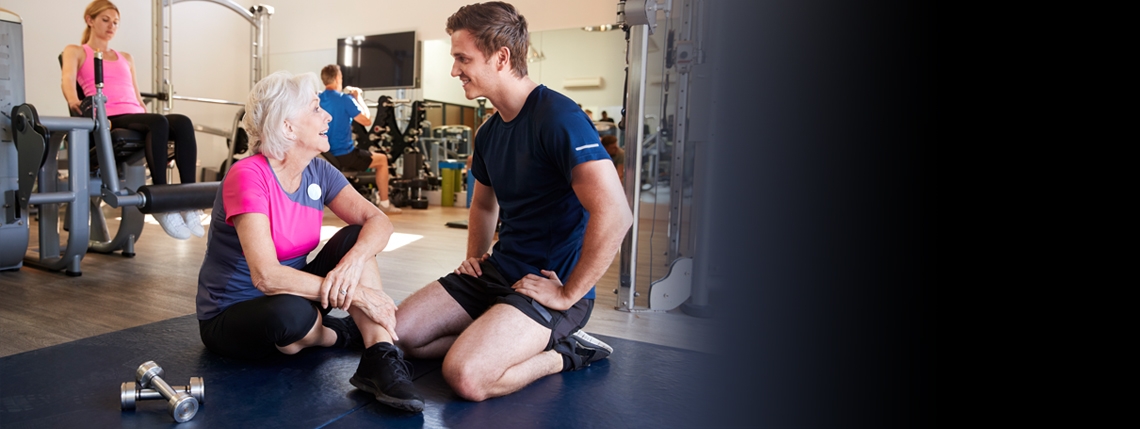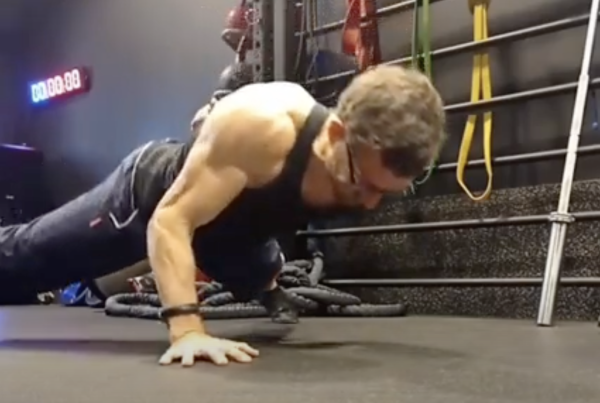A briefing for exercise professionals: Considerations when helping people return to exercise and physical activity
Louise Burgess and Tom Wainwright delve into the very latest research and take a technical look at the broader considerations when returning to exercise following COVID-19. Relevant to every single fitness professional who is tasked with helping someone get back to fitness after the illness, this advice is also transferrable to family and friends who have been through COVID-19.
Overview
This is a non-exhaustive briefing intended to guide exercise professionals on the late-stage recovery of individuals affected by COVID-19. It covers a general background to COVID-19 and highlights some important physiological and psychological considerations for individuals who seek advice on returning to physical activity and exercise. Specifically, we describe what the acute and sub-acute phases of recovery will involve, and how this management may affect late-stage rehabilitation. This group will require gradual and personalised return-to-exercise programmes, inclusive of self-management strategies. One size will not fit all and exercise professionals will be well placed to provide expert exercise prescription, underpinned by considerations specific to the effects of COVID-19 and its related treatments.
1.Background
The World Health Organisation (WHO) declared a global pandemic on 12 March 2020 following the outbreak of the severe acute respiratory syndrome coronavirus 2 (SARS-CoV2, or COVID-19), which first emerged in Wuhan, China, in December 2019.1 Individuals with COVID-19 can present with an influenza-like illness and respiratory tract infection, demonstrating symptoms including fever, a dry cough, fatigue, sputum production and/or shortness of breath.2 The disease severity ranges from an asymptomatic infection, to a mild respiratory tract illness, to severe viral pneumonia with respiratory failure and/or death.3 Of those who test positive for COVID-19, approximately 81% of cases are asymptomatic or mild; around 14% develop severe disease requiring hospitalisation and oxygen support; and 5% are critical, requiring admission to an intensive care unit (ICU) for ventilation and life support.4
Global reported cases of COVID-19 surpassed three million in April 2020,5 although it is predicted the actual number of cases is much higher. In the United Kingdom (UK), over 180,000 cases were confirmed as of May 2020. An analysis of 16,749 patients with severe COVID-19 admitted to a UK hospital found that 49% of patients were discharged home, 33% died in hospital and 17% continued to receive care at the date of reporting.6 Of these patients, 17% required admission to high dependency or intensive care units (ICU).6 The median age of the hospitalised patients was 72 years, ranging from 0-104, and their median duration of hospital stay was seven days.6 Common comorbidities of admitted patients were: chronic cardiac disease (29%), uncomplicated diabetes (19%), non-asthmatic chronic pulmonary disease (19%) and asthma (14%).6
2.Recovery from COVID-19
Healthcare systems around the world are currently overwhelmed by the immediate and urgent needs of patients with COVID-19. Appropriately, much attention has addressed the acute challenges in caring for the surge of critically ill patients.7 For survivors of COVID-19, the sub-acute phase of recovery aims to address chronic fatigue, counteract immobilisation and address cognitive impairments in order to facilitate discharge home and create much-needed bed space.7-11 In the post-acute phase, patients may require multidisciplinary support from primary care practitioners to address the clinical conditions caused by severe respiratory illness, secondary disabilities and intensive care treatments.8 In the longer term, survivors of COVID-19 will look to return to their normal functional status and activities of daily living. Physical activity and exercise will be valuable tools to address persistent respiratory insufficiencies, muscle deconditioning and psychological impairments that may impede optimal quality of life.12-14 Hence, the sports and exercise industry, including personal trainers, must start to prepare for and consider these rehabilitation needs as the world recovers from the pandemic.15,16 Without a co-ordinated and multidisciplinary approach to support patients in their long-term recovery, there may be a rise in chronic psychological and physical deterioration,17 posing a significant societal risk. This article highlights some considerations for returning to physical activity and exercise for people in the later stages of recovering from COVID-19.
3.Considerations when returning to exercise and physical activity
3.1 Understanding the readiness of clients to return to exercise
Upon return to exercise, survivors of COVID-19 may present with a variety of musculoskeletal, cardiopulmonary, neurological and psychological symptoms that will need to be addressed on an individual basis. The severity of virus symptoms, and interventions received, if any, in the acute phase will largely influence how the patient responds when returning to physical activity. Critically ill patients may be considered for conservative intravenous fluids: intravenous antibiotics, oxygenation, intubation and ventilation.18 The longer a patient remains in ICU, the higher the risk of long-term physical, cognitive and emotional complications related to post-intensive care syndrome,14 including ICU-acquired weakness, acute brain dysfunction, hypoxia, hypertension and glucose dysregulation.19 Patients with pre-existing medical conditions will be more severely affected and likely to require more complex and individualised treatment.15 Therefore, prior to scheduling a new client, a comprehensive Physical Activity Readiness Questionnaire (PAR-Q) should be completed, including questions related to their medical history, COVID-19 symptoms, treatment, if they were ventilated, if they were diagnosed with pneumonia, the number of days spent in hospital, time since discharge and a detailed list of comorbidities. At this stage, it is also important to identify any changes to the individual’s weight, sleeping habits or cognitions, during or following recovery from COVID-19.
3.2 Cardio-pulmonary considerations
Respiratory impairments may persist or manifest as clinical symptoms during long-term recovery and return to exercise, such as shortness of breath, shortness of breath on exertion, dysfunctional breathing patterns, hyperventilation or difficulty clearing secretions, due to impaired lung function and respiratory muscle strength.20 The survivors of the 2003 Severe Acute Respiratory Syndrome (SARS) outbreak suffered markedly diminished exercise capacity and health status when compared to the general population, 12 months following their initial illness.21 24% and 28% of the survivors had impaired diffusing capacity of carbon monoxide in the lung and abnormal chest radiographs, respectively.21 In patients who have been mechanically ventilated, diaphragm proteolysis and atrophy occur,22 and respiratory muscle weakness has been observed while ventilated23 and following extubation.24 Hence, inspiratory muscles are often weak and subject to fatigue, which can contribute to dyspnoea and limited functional recovery in ICU survivors.25 Training techniques involving inspiratory muscle training are proposed to improve inspiratory muscle strength and health-related quality of life in patients recently extubated.26 In addition, traditional pulmonary rehabilitation techniques, such as progressive exercise training, including both aerobic (continuous or interval) and resistance training, combined with structured education and ongoing exercise maintainance,27 may be considered to improve respiratory function.
While exercise training is an essential component of pulmonary rehabilitation, a subset of patients may experience exercise-induced hypoxemia, characterised by oxygen deficiency in the arterial blood.28 This may present as symptoms such as substantial tachycardia or arrhythmias, severe dyspnoea, hypotensive dizziness or chest pain. Low-intensity exercise is recommended until clinical symptoms such as dyspnoea, oxygen saturation and heart rate support the safety of incremental increase in intensity, based upon clinical stability.28
It is reasonable to expect that severe cases of COVID-19 will suffer more severe effects on the cardiovascular system, owing to more robust inflammatory response.29 While it is not certain whether cardiovascular risk will remain in the long term, heightened systemic inflammatory and pro-coagulant activity can persist in survivors of hospitalisation for pneumonia, long after the resolution of the initial infection.30 Hence, it has been suggested that cardiovascular complications should be closely monitored following resolution of the acute phase of COVID-19.31
3.3 Neurological considerations
Some patients recovering from COVID-19 may exhibit neurological symptoms related to low oxygen (hypoxia) in the acute period of illness, and to treatments given in the acute phase of recovery. For example, sedative drugs and analgesics are routinely used in critically ill patients, and have the potential for side effects such as delirium and sleep disruption.32 Neurological symptoms will likely be more common in patients who report having suffered from delirium within their recovery, and may present as dizziness and headaches, as well as impaired co-ordination when attempting exercises with a dynamic balance and/or proprioceptive element. For these individuals, static and dynamic balance training may help to address balance dysfunction.8
3.4 Musculoskeletal considerations
Exercise professionals will also be well placed to address muscle disuse atrophy and peripheral muscle weakness through strength-training techniques. Functional disability in SARS survivors has been reported as disproportionate when compared to the degree of lung function impairment, suggesting additional factors relating to muscle deconditioning and critical illness-related neuropathy/myopathy should be considered.12 21 Skeletal muscle wasting and weakness are significant complications of critical illness, associated with degree of illness severity and periods of reduced mobility during mechanical ventilation.33 Following discharge from the ICU, rehabilitation is paramount to counteract the persistent physical and functional deficits which may exist long after discharge, and can markedly affect quality of life.34 Similarly, while effective in reducing the spread of COVID-19, self-isolation represents a severe limitation of patients’ movement. As a result of fever and fatigue, even patients who experience mild symptoms and do not require hospitalisation may present with a muscular strength decrease.8
3.5 Activity pacing
Activity pacing is a strategy frequently implemented to modify activities among patients with chronic conditions, such as pain or fatigue.35 Persistent fatigue was observed in survivors of the 2003 SARS outbreak, three years following the outbreak, in addition to sleep disorders and myalgia.36 Hence, paced activity, in combination with adequate sleep and nutrition, are important for patients during their ongoing recovery from COVID-19. While the nature and content of pacing varies among different approaches, a symptom-contingent strategy, whereby activities are driven by perceived symptom levels with the aim of avoiding exacerbation of symptoms, is considered most appropriate when recovering from a viral infection. Symptom-contingent pacing is underpinned by energy conservation, and approaches can be as simple as self-assessment of symptoms (for example, reporting fatigue on a scale of 0-100), or utilising a heart rate monitor, with the aim of monitoring symptoms to avoid exacerbation.37 Other pacing techniques include the quota-contingent approach, whereby activities are undertaken in accordance with a goal, distance or sought amount, with the aim of improving function.35 This technique should be used in caution in cases of post-viral fatigue, as patients who push themselves too far too soon may exacerbate their symptoms and subsequently decline in ability.
3.6 Psychological considerations
Based upon the psychosocial impact of previous viral epidemics, exercise professionals must also prepare for the neuropsychological morbidity related to COVID-19.38 A 12-month follow-up of SARS survivors found evidence of psychiatric morbidity in 64% of the tested population, including evidence of depression, anxiety and post-traumatic stress,39 highlighting the importance of identifying and addressing psychological morbidity before it becomes chronic. In the absence of routine hospital follow-up, exercise professionals may be best placed to signpost timely psychiatric support tools and treatments for those presenting with psychological trauma. It is thought those with pre-existing mental health disorders may be more substantially influenced by the emotional responses brought on by the pandemic, resulting in relapses or worsening of the existing disorder due to high susceptibility to stress compared with the general population.40 With disease progression, clinical symptoms become severe and psychological trauma will likely progress in due course.41 For example, critically ill patients admitted to the ICU may suffer from anxiety, depression, post-traumatic stress, delirium and cognitive impairment.42 Treatment of COVID-19 itself can result in adverse psychological effects, such as insomnia caused by corticosteroids38 or delirium due to sedative drugs prescribed to suppress coughing.
4.0 Summary
Our hospitals are currently consumed by responding to the acute care needs of patients with COVID-19. As patients recover, there will be a subsequent need in the longer term for exercise professionals to help these patients return to physical activity and exercise. Exercise professionals will be well placed to facilitate a safe return to exercise, underpinned by considerations specific to COVID-19 and the sequela of its acute presentation. Training plans and exercise prescription will need to be adapted in line with the severity of illness, patient age, prior fitness levels and pre-existing comorbidities. To deliver this, exercise professionals should ensure they have an understanding of COVID-19, its acute presentation and its sub-acute management, so that they can effectively assist in the later stages of rehabilitation. This knowledge will not only help exercise professionals to be more effective in their interventions, but will importantly also allow them to troubleshoot and identify when referral and/or help from acute and community care providers is required for their clients.
Author bios

Tom Wainwright is a physiotherapist and Associate Professor in Orthopaedics at the Orthopaedic Research Institute, Bournemouth University. He is internationally recognised for his work on Enhanced Recovery after Surgery protocols, and he has active research projects related to osteoarthritis, orthopaedic surgery, and rehabilitation.
https://staffprofiles.bournemouth.ac.uk/display/twainwright
https://twitter.com/twwainwright

Louise Burgess is a research assistant and PhD candidate at the Orthopaedic Research Institute, Bournemouth University. Her research interests include the conservative management of osteoarthritis, orthopaedic surgery and related diseases, treatments and technologies.
https://staffprofiles.bournemouth.ac.uk/display/lburgess
https://twitter.com/louise_burgess1
References
- World Health Organisation. WHO characterises COVID-19 as a pandemic 2020 [16th April 2020]. Available from: https://www.who.int/emergencies/diseases/novel-coronavirus-2019/events-as-they-happen accessed 16th April 2020.
- Fu L, Wang B, Yuan T, et al. Clinical characteristics of coronavirus disease 2019 (COVID-19) in China: a systematic review and meta-analysis. J Infect 2020 doi: 10.1016/j.jinf.2020.03.041 [published Online First: 2020/04/14]
- Thomas P, Baldwin C, Bissett B, et al. Physiotherapy management for COVID-19 in the acute hospital setting: clinical practice recommendations. Journal of Physiotherapy 2020 doi: 10.1016/j.jphys.2020.03.011
- Novel Coronavirus Pneumonia Emergency Response Epidemiology Team. [The epidemiological characteristics of an outbreak of 2019 novel coronavirus diseases (COVID-19) in China]. Zhonghua Liu Xing Bing Xue Za Zhi 2020;41(2):145-51. doi: 10.3760/cma.j.issn.0254-6450.2020.02.003 [published Online First: 2020/02/18]
- John Hopkins University. Coronavirus Resource Centre 2020 [Available from: https://coronavirus.jhu.edu/map.html accessed 1st May 2020.
- Docherty AB, Green CA et al. Features of 16,749 hospitalised UK patients with COVID-19 using the ISARIC WHO Clinical Characterisation Protocol. [preprint] 2020
- Grabowski DC, Joynt Maddox KE. Postacute Care Preparedness for COVID-19: Thinking Ahead. JAMA 2020 doi: 10.1001/jama.2020.4686 [published Online First: 2020/03/27]
- Brugliera L, Spina A, Castellazzi P et al. Rehabilitation of COVID-19 patients.pdf. 2020 doi: 10.2340/16501977-xxxx
- Simpson R, Robinson L. Rehabilitation following critical illness in people with COVID-19 infection. Am J Phys Med Rehabil 2020 doi: 10.1097/PHM.0000000000001443 [published Online First: 2020/04/14]
- Choon-Huat Koh G, Hoenig H. How Should the Rehabilitation Community Prepare for 2019-nCoV? Arch Phys Med Rehabil 2020 doi: 10.1016/j.apmr.2020.03.003 [published Online First: 2020/03/21]
- Borg K, Stam H. Editorial: Covid-19 and Physical and Rehabilitation Medicine. J Rehabil Med 2020;52(4):jrm00045. doi: 10.2340/16501977-2679 [published Online First: 2020/04/15]
- Hui DS, Wong KT, Ko FW, et al. The 1-year impact of severe acute respiratory syndrome on pulmonary function, exercise capacity, and quality of life in a cohort of survivors. Chest 2005;128(4):2247-61. doi: 10.1378/chest.128.4.2247 [published Online First: 2005/10/21]
- Su MC, Hsieh YT, Wang YH, et al. Exercise capacity and pulmonary function in hospital workers recovered from severe acute respiratory syndrome. Respiration 2007;74(5):511-6. doi: 10.1159/000095673 [published Online First: 2006/09/09]
- Stam HJ, Stucki G, Bickenbach J. Covid-19 and Post Intensive Care Syndrome: A Call for Action. J Rehabil Med 2020;52(4):jrm00044. doi: 10.2340/16501977-2677 [published Online First: 2020/04/15]
- The Chartered Society of Physiotherapy. Rehabilition During and After the Covid-19 Pandemic. A CSP Policy Statement, 2020.
- Murray A GC, Morris J. We need a Nightingale model for rehab after covid-19. 2020 [Available from: https://www.hsj.co.uk/commissioning/we-need-a-nightingale-model-for-rehab-after-covid-19-/7027335.article accessed 16th April 2020.
- Boldrini P, Bernetti A, Fiore P, et al. Impact of COVID-19 outbreak on rehabilitation services and Physical and Rehabilitation Medicine (PRM) physicians’ activities in Italy. An official document of the Italian PRM Society (SIMFER). Eur J Phys Rehabil Med 2020 doi: 10.23736/S1973-9087.20.06256-5 [published Online First: 2020/03/17]
- Murthy S, Gomersall CD, Fowler RA. Care for Critically Ill Patients With COVID-19. JAMA 2020 doi: 10.1001/jama.2020.3633 [published Online First: 2020/03/12]
- Rawal G, Yadav S, Kumar R. Post-intensive Care Syndrome: an Overview. J Transl Int Med 2017;5(2):90-92. doi: 10.1515/jtim-2016-0016 [published Online First: 2017/07/20]
- Fan E, Dowdy DW, Colantuoni E, et al. Physical complications in acute lung injury survivors: a two-year longitudinal prospective study. Crit Care Med 2014;42(4):849-59. doi: 10.1097/CCM.0000000000000040 [published Online First: 2013/11/20]
- Hui DS, Wong KT, Antonio GE, et al. Long-term sequelae of SARS: physical, neuropsychiatric, and quality-of-life assessment. Hong Kong Med J 2009;15 Suppl 8:21-3. [published Online First: 2010/04/27]
- Levine S, Nguyen T, Taylor N, et al. Rapid disuse atrophy of diaphragm fibers in mechanically ventilated humans. N Engl J Med 2008;358(13):1327-35. doi: 10.1056/NEJMoa070447 [published Online First: 2008/03/28]
- De Jonghe B, Bastuji-Garin S, Durand MC, et al. Respiratory weakness is associated with limb weakness and delayed weaning in critical illness. Crit Care Med 2007;35(9):2007-15. doi: 10.1097/01.ccm.0000281450.01881.d8 [published Online First: 2007/09/15]
- Chang AT, Boots RJ, Brown MG, et al. Reduced inspiratory muscle endurance following successful weaning from prolonged mechanical ventilation. Chest 2005;128(2):553-9. doi: 10.1378/chest.128.2.553 [published Online First: 2005/08/16]
- Bissett B, Leditschke IA, Neeman T, et al. Weaned but weary: one third of adult intensive care patients mechanically ventilated for 7 days or more have impaired inspiratory muscle endurance after successful weaning. Heart Lung 2015;44(1):15-20. doi: 10.1016/j.hrtlng.2014.10.001 [published Online First: 2014/12/03]
- Bissett BM, Leditschke IA, Neeman T, et al. Inspiratory muscle training to enhance recovery from mechanical ventilation: a randomised trial. Thorax 2016;71(9):812-9. doi: 10.1136/thoraxjnl-2016-208279 [published Online First: 2016/06/04]
- British Thoracic Society. Quality Standards for Pulmonary Rehabilitation in Adults. British Thoracic Society Reports, 2014.
- Garvey C, Tiep B, Carter R, et al. Severe exercise-induced hypoxemia. Respir Care 2012;57(7):1154-60. doi: 10.4187/respcare.01469 [published Online First: 2012/02/14]
- Madjid M, Safavi-Naeini P, Solomon SD, et al. Potential Effects of Coronaviruses on the Cardiovascular System: A Review. JAMA Cardiol 2020 doi: 10.1001/jamacardio.2020.1286 [published Online First: 2020/03/29]
- Xiong TY, Redwood S, Prendergast B, et al. Coronaviruses and the cardiovascular system: acute and long-term implications. Eur Heart J 2020 doi: 10.1093/eurheartj/ehaa231 [published Online First: 2020/03/19]
- Celli B, Fabbri LM. Urgent need of a management plan for survivors of COVID-19. Eur Respir J 2020;55(4) doi: 10.1183/13993003.00764-2020 [published Online First: 2020/03/29]
- Pandharipande P, Ely EW. Sedative and analgesic medications: risk factors for delirium and sleep disturbances in the critically ill. Crit Care Clin 2006;22(2):313-27, vii. doi: 10.1016/j.ccc.2006.02.010 [published Online First: 2006/05/09]
- Connolly B, Salisbury L, O’Neill B, et al. Exercise rehabilitation following intensive care unit discharge for recovery from critical illness. Cochrane Database Syst Rev 2015(6):CD008632. doi: 10.1002/14651858.CD008632.pub2 [published Online First: 2015/06/23]
- Wainwright T.W. MDA, Burgess L.C. The role of physiotherapy in Enhanced Recovery after Surgery in the intensive care unit. ICU Management & Practice 2017;17(3):144-47.
- Antcliff D, Keeley P, Campbell M, et al. Activity pacing: moving beyond taking breaks and slowing down. Qual Life Res 2018;27(7):1933-35. doi: 10.1007/s11136-018-1794-7 [published Online First: 2018/02/06]
- Moldofsky H, Patcai J. Chronic widespread musculoskeletal pain, fatigue, depression and disordered sleep in chronic post-SARS syndrome; a case-controlled study. BMC Neurol 2011;11:37. doi: 10.1186/1471-2377-11-37 [published Online First: 2011/03/26]
- Goudsmit EM, Nijs J, Jason LA, et al. Pacing as a strategy to improve energy management in myalgic encephalomyelitis/chronic fatigue syndrome: a consensus document. Disabil Rehabil 2012;34(13):1140-7. doi: 10.3109/09638288.2011.635746 [published Online First: 2011/12/21]
- Xiang YT, Yang Y, Li W, et al. Timely mental health care for the 2019 novel coronavirus outbreak is urgently needed. Lancet Psychiatry 2020;7(3):228-29. doi: 10.1016/S2215-0366(20)30046-8 [published Online First: 2020/02/08]
- Lee AM, Wong JG, McAlonan GM, et al. Stress and psychological distress among SARS survivors 1 year after the outbreak. Can J Psychiatry 2007;52(4):233-40. doi: 10.1177/070674370705200405 [published Online First: 2007/05/16]
- Yao H, Chen JH, Xu YF. Patients with mental health disorders in the COVID-19 epidemic. Lancet Psychiatry 2020;7(4):e21. doi: 10.1016/S2215-0366(20)30090-0 [published Online First: 2020/03/23]
- Duan L, Zhu G. Psychological interventions for people affected by the COVID-19 epidemic. Lancet Psychiatry 2020;7(4):300-02. doi: 10.1016/S2215-0366(20)30073-0 [published Online First: 2020/02/23]
- Rattray J. Life after critical illness: an overview. J Clin Nurs 2014;23(5-6):623-33. doi: 10.1111/jocn.12379 [published Online First: 2013/09/17]







